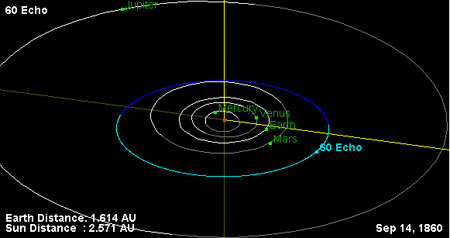Astronomy:60 Echo
 Three-dimensional model of 60 Echo created based on light-curve | |
| Discovery | |
|---|---|
| Discovered by | James Ferguson |
| Discovery date | September 14, 1860 |
| Designations | |
| (60) Echo | |
| Pronunciation | /ˈɛkoʊ/ |
| Named after | Echo |
| Minor planet category | Main belt |
| Adjectives | Echoian /ɛˈkoʊ.iən/ |
| Orbital characteristics | |
| Epoch December 31, 2006 (JD 2454100.5) | |
| |{{{apsis}}}|helion}} | 2.830 astronomical unit|AU (423.4 Gm) |
| |{{{apsis}}}|helion}} | 1.958 astronomical unit|AU (292.9 Gm) |
| 2.394 astronomical unit|AU (358.1 Gm) | |
| Eccentricity | 0.182 |
| Orbital period | 1,353.002 d (3.70 yr) |
| Mean anomaly | 91.065° |
| Inclination | 3.602° |
| Longitude of ascending node | 191.803° |
| 270.477° | |
| Physical characteristics | |
| Dimensions | 60.2 km[1] |
| Mass | (3.15 ± 0.32) × 1017 kg[2] |
| Mean density | 2.78 ± 0.33[2] g/cm3 |
| Rotation period | 25.2 hr[1] |
| Geometric albedo | 0.254[1][3] |
| S[1] | |
| Absolute magnitude (H) | 8.21[1] |
Echo (minor planet designation: 60 Echo) is a quite large main-belt asteroid. It was discovered by James Ferguson of the United States Naval Observatory in Washington D.C., on September 14, 1860. It was his third and final asteroid discovery. It is named after Echo, a nymph in Greek mythology. James Ferguson had initially named it "Titania", not realizing that name was already used for a satellite of Uranus.[4]
This object is orbiting the Sun with a period of 3.70 years, a semimajor axis of 2.394 astronomical unit|AU, and an eccentricity of 0.18. Its orbital plane is at an inclination of 3.6° to the plane of the ecliptic. This is a stony S-type asteroid with a cross-sectional size of 60.2 km that is spinning with a rotation period of 25.2 hr.[1] Echo has been studied by radar.[5] It is not known to be a member of any asteroid family.[6]
References
- ↑ 1.0 1.1 1.2 1.3 1.4 1.5 "JPL Small-Body Database Browser: 60 Echo". Jet Propulsion Laboratory. https://ssd.jpl.nasa.gov/sbdb.cgi?sstr=60.
- ↑ 2.0 2.1 Carry, B. (December 2012), "Density of asteroids", Planetary and Space Science 73: pp. 98–118, doi:10.1016/j.pss.2012.03.009, Bibcode: 2012P&SS...73...98C. See Table 1.
- ↑ "Asteroid Data Sets". http://www.psi.edu/pds/resource/albedo.html.
- ↑ Appletons' annual cyclopaedia and register of important events of the year: 1862. New York: D. Appleton & Company. 1863. p. 173. https://archive.org/stream/1862appletonsan02newyuoft#page/n180/mode/1up.
- ↑ "Radar-Detected Asteroids and Comets". NASA/JPL Asteroid Radar Research. http://echo.jpl.nasa.gov/asteroids/.
- ↑ Carruba, V.; Aljbaae, S.; Winter, O. C. (January 2016), "On the Erigone family and the z2 secular resonance", Monthly Notices of the Royal Astronomical Society 455 (3): 2279–2288, doi:10.1093/mnras/stv2430, Bibcode: 2016MNRAS.455.2279C
External links
- 60 Echo at AstDyS-2, Asteroids—Dynamic Site
- 60 Echo at the JPL Small-Body Database
 |


